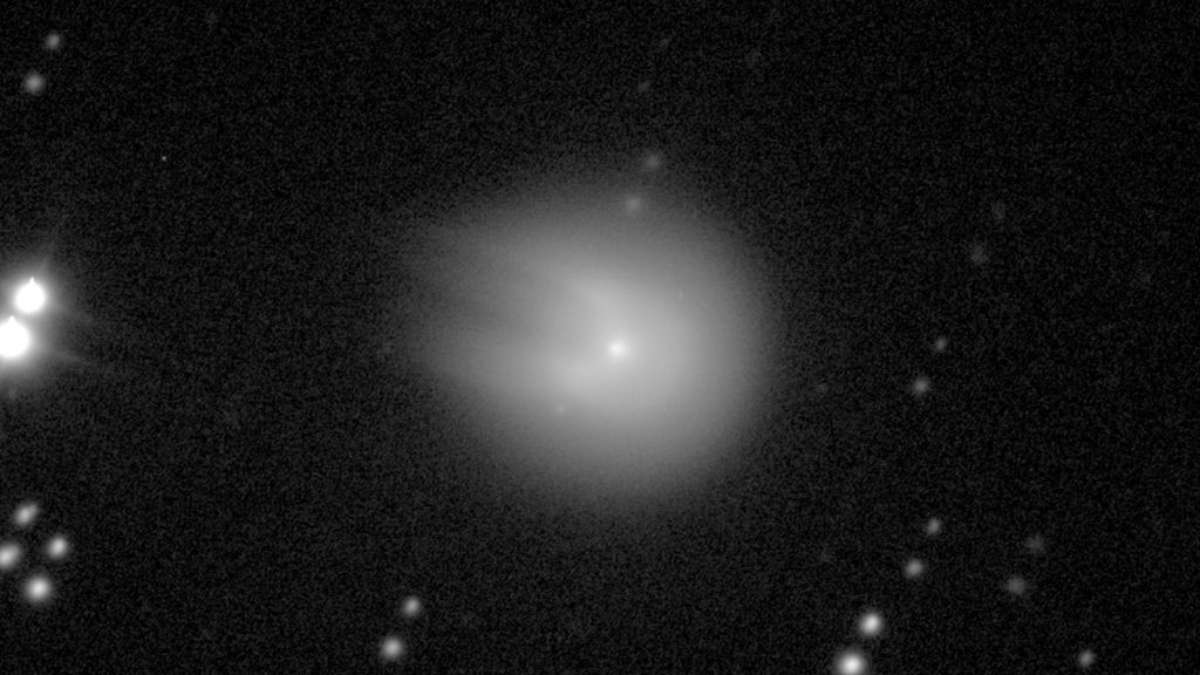The nickname “Devil’s Comet” is due to the fact that its tail sometimes resembles a pair of horns (Image: Reproduction/Comet Chasers/Students at St Mary’s Primary School Bridgend)
Foto: Canaltech
O cometa 12P/Pons-Brooks is about to reach its closest point in its orbit to Earth. If the name doesn’t sound familiar to you, it’s worth remembering that it is known as the “Devil’s Comet“, and it’s bigger than Mount Everest!
What does this proximity mean? That it can be seen with the naked eye in the coming weeks, in a rare astronomical event that happens every 71 years, the time in which the comet completes an orbit around the Sun.
In other words, it is seen from Earth only once during this period, making it a once-in-a-lifetime experience.
Naked eye observation
The comet moves from the constellation Andromeda to Pisces, thereby passing bright stars that will make it easier to locate on certain dates. So, write it down:
- In particular, on March 31, 12P/Pons-Brooks will be just 0.5 degrees from the bright star called Hamal — explained Paul Strøm, an astrophysicist at the University of Warwick, in an interview with The Guardian.
- For now, the comet is best seen from the Northern Hemisphere, but its observation will become easier as it approaches the Sun.
- Perihelion, the name given to the point in the orbit closest to the star, should occur on April 21, 2024.
- From that date onwards, it should become more visible in the Southern Hemisphere, while it will no longer be observable in the North;
- On June 2, the comet will be closest to Earth, about 232 million kilometers. It will still be observable, but with the help of binoculars, as it will be further from the Sun.
- After approaching us, the space rock will be gravitationally launched back into the outer solar system and will not return until 2095.
Astronomical calendar 2024 will have “Devil’s Comet”, supermoon and more eclipse
Devil’s Comet
The celestial body is popularly known by this nickname due to its appearance, which resembles horns during phases of greatest activity.
The comet has been compared to Star Wars’ Millennium Falcon, because of its pair of ‘horns’ seen in the images. Amateur astronomers have already taken photos of 12P/Pons-Brooks with specialized telescopes, but it should soon become visible to the naked eye.
According to astronomer Richard Miles, from the British Astronomical Association, in a statement to the website Spaceweather.com, this comet has behavior comparable to that of a geyser, due to its periodic eruption of ice and gas.
It is approximately 30 kilometers in diameter — about three times the size of Mount Everest. According to observations, it goes through episodes of activity every fifteen days.
The episodes of activity of this comet are true cryovolcanic events, in which it releases a mixture of gases and ice. This occurs as it approaches the Sun, heating up and building up internal pressure until the explosive release of nitrogen and carbon monoxide shoots icy debris into space.
This process creates stunning views in the sky that have been compared to devil’s horns or even science fiction spaceships.
But rest assured, despite its proximity to our planet, experts say that the Devil’s Comet poses no risk to Earth.
The name is what is attracting the most attention on the internet. Despite being officially called 12P/Pons-Brooks, it became known as the “Devil’s Comet” because it had two “horns” made of ice and gas.
Foto: Comet Chasers/Richard Miles / Flipar
Tips on how to observe:
To see Comet 12P/Pons-Brooks, look west in the night sky and find the Great Square of Pegasus – the four stars of almost equal brightness.
Over the next few weeks, the comet will move from the Great Square of Pegasus toward Aries the Ram, which forms a loose V shape.
While it is difficult to predict what a comet will look like and how bright it will become, the public should keep an eye out for what appears to be “an irregularly shaped dirty snowball.”
Ideally, according to experts, you should go somewhere with a clear view of the western horizon and choose a night with clear skies.
When this close approach occurs, 12P/Pons-Brooks is expected to be visible to the naked eye as a faint star-like speck with a hazy tail.
Source: Byte Editorial
2024-03-12 13:32:00
#Devils #Comet #visible #naked #eye #observe


:watermark(https://f.pmo.ee//logos/4238/c14433e7c257b86e167cf144389f5071.png,-2p,-2p,0,18,none)/nginx/o/2022/05/31/14591220t1ha7bb.jpg)